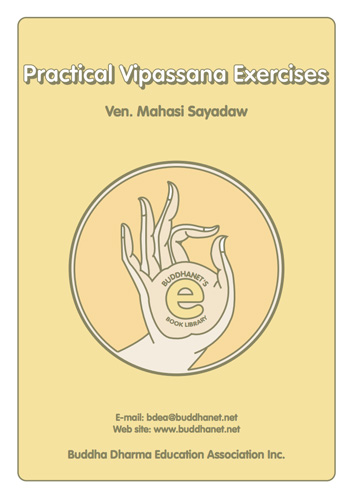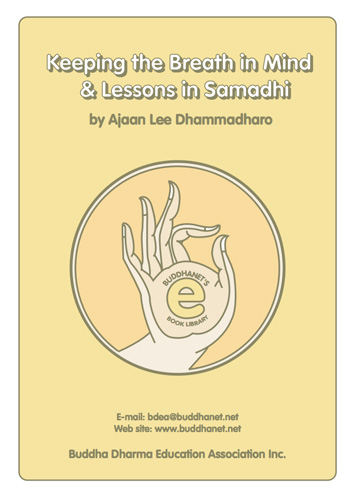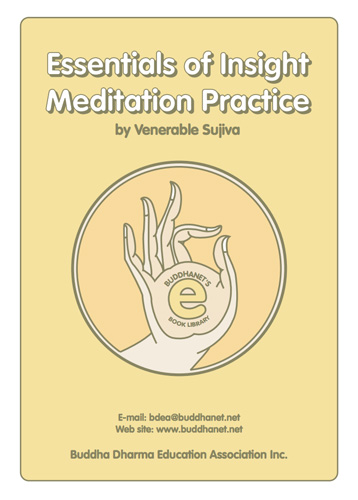 Most viewed - eBook Library Most viewed - eBook Library |

prajparagen2.pdfThe Diamond Sutra6927 viewsThis sutra says, One should produce a heart without dwelling anywhere. The Sixth Patriarch, the Great Master Hui, heard that sentence and awakened to the Way. Any dwelling of the heart is no dwelling. Therefore, the Larger Chapters say, If one dwells in dharmas, he does not dwell in prajna paramita. If one does not dwell in dharmas, he dwells in prajna paramita. That is why every one of the Great Prajna assemblies begins with an explanation of not dwelling.
|
|

mahasit1.pdfPractical Vipassana Exercises6893 viewsThe late Mahasi Sayadaw was responsible for the modern revival of Vipassana or Insight meditation in Myanmar (Burma). This text is his basic instruction on the practice: the preparatory stages with a series of basic exercises. Part two, deals with the deals with the progressive practice and the practical vipassana exercises. The appendix explains the techniques involved in the Mahasi Sayadaw tradition.
|
|

Aggregates.pdfA Burden Off the Mind: A Study Guide on the Five Aggregates6796 viewsOne of the new concepts most central to the Buddha's teaching was that of the khandhas, usually translated into English as “aggregates.†Prior to the Buddha, the Pali word khandha had very ordinary meanings: A khandha could be a pile, a bundle, a heap, a mass. It could also be the trunk of a tree. In his first sermon, though, the Buddha gave it a new, psychological meaning, introducing the term “clinging-khandhas†to summarize his analysis of the truth of stress and suffering. Throughout the remainder of his teaching career, he referred to these psychological khandhas time and again. Their importance in his teachings has thus been obvious to every generation of Buddhists ever since.
|
|

breathmind.pdfKeeping the Breath in Mind & Lessons in Samadhi6725 viewsThis is a 'how to' book. It teaches the liberation of the mind, not as a mind-boggling theory, but as a very basic skill that starts with keeping the breath in mind. The teachings here are drawn from the works of Ajaan Lee Dhammadharo (1906-61), one of Thailand's most renowned teachers of Buddhist meditation practices. Ajaan Lee was a forest monk - one who prefers to live in the seclusion of the forest and makes his meditation the central theme of his practice - so his teachings grow out of personal, practical experience, although he also makes a point of relating them to standard Buddhist doctrine.
|
|

ThePurposeofLife.pdfThe Purpose of Life and Other Teachings6610 viewsThis book gives very clear, practical and direct advice to those who seek to achieve an understanding of their life on earth, and how to lead a noble and peaceful life amidst the confusion, murkiness, materialism and strong craving that this age heralds. Ven. Dhammananda shows us the real nature of worldly life, giving us a correct understanding of life as it is and puts worldly pleasures into its right perspective.
|
|

essentials.pdfEssentials of Insight Meditation Practice6374 viewsThe ultimate aim of insight meditation is to free one from the unsatisfactoriness of cyclic existence. Readers may also find numerous quotations of the Buddha's teaching on mindfulness, detachment and liberation throughout the entire book. Those verses act as a source of inspiration and purpose to put vipassana into practice - a practice that brings about insight into the three universal characteristics of unsatisfactoriness, impermanence and non-self which leads one into detachment and ultimate liberation.
|
|

becoming1.pdfBecoming Your Own Therapist6361 viewsLord Buddha's timeless teachings are as universally relevant today as they were when they were first given, over 2,500 years ago, as Lama explains in these three general talks on the philosophy, psychology and practice of Buddhism. Although called lectures, these talks are not intended to be didactic, but rather for us to use as a mirror for our minds, to allow us to look beyond the words, find ourselves, and become our own psychologist. Each lecture is followed by an informative question and answer session
|
|

allmetta.pdfLoving-kindness Meditation6322 viewsVen. Sujiva
Loving-kindness Meditation or Metta Bhavana and other Sublime States by Ven. Sujiva is a clear and comprehensive step-by-step explanation of the systematic practice. It is based on the Visuddhimagga or The Path of Purification by Buddhagosha. The texts describe metta as characterised by promoting the aspect of welfare. Amity, goodwill, friendliness and loving-kindness are some words used to describe this mental state. There is no better way to know it than to study it as it occurs in one's own and others' minds. It is a totally unselfish and pure state of mind that brings profit to oneself and others now and hereafter.
|
|

whatbelieve.pdfWhat Buddhists Believe6245 viewsThis expanded 4th edition of What Buddhists Believe answers many questions which are asked about Buddhism by Buddhists and non-Buddhists alike. There are so many misconceptions regarding superstitions and misinterpretations which are associated with this noble religion that it has become imperative to explain the Teachings in a manner which has contemporary relevance.
|
|

jataka_p.pdfBuddhist Tales for Young & Old (Vol. 2)6200 viewsThis is the illustrated version of Buddhist Tales for Young and Old (volume 2), with line drawings by John Patterson, which are suitable for colouring in.
|
|
| 347 files on 35 page(s) |
 |
3 |  |
 |
 |
 |
 |
|
